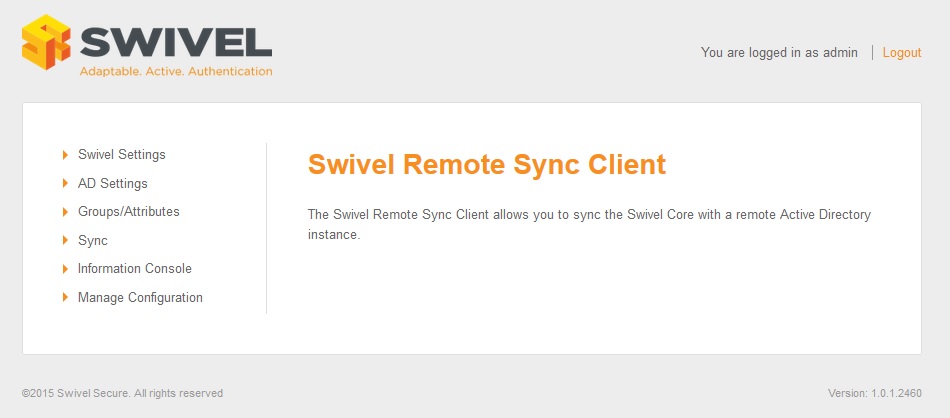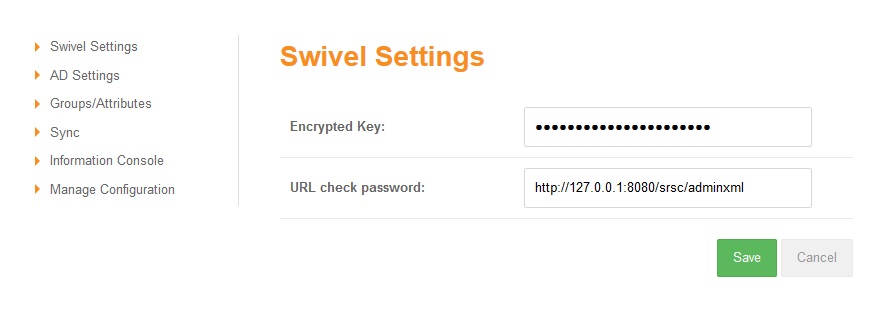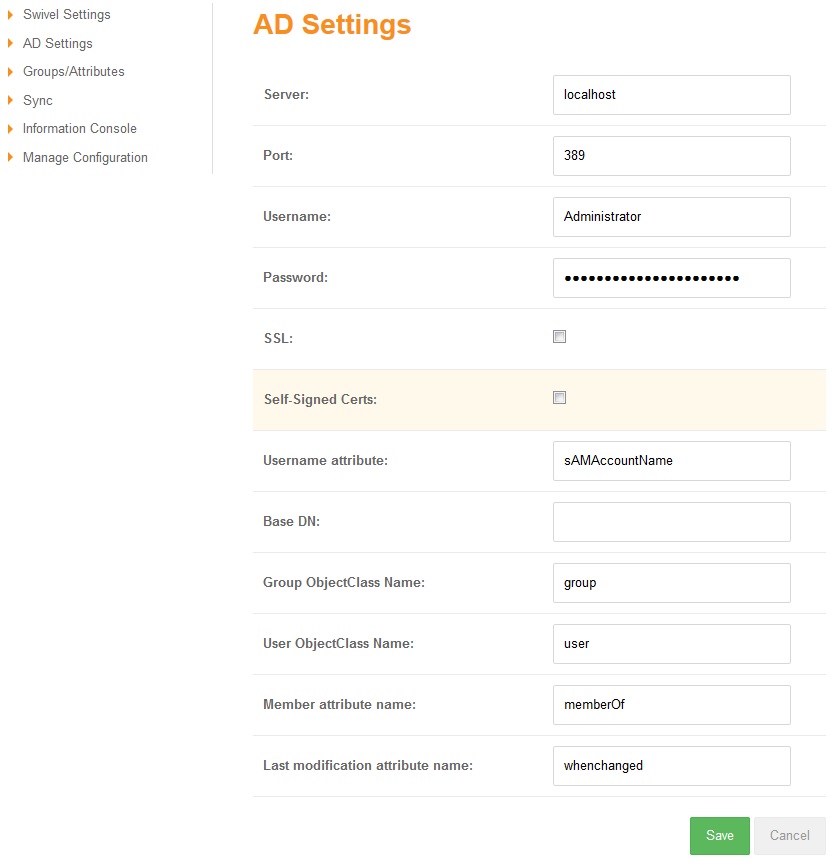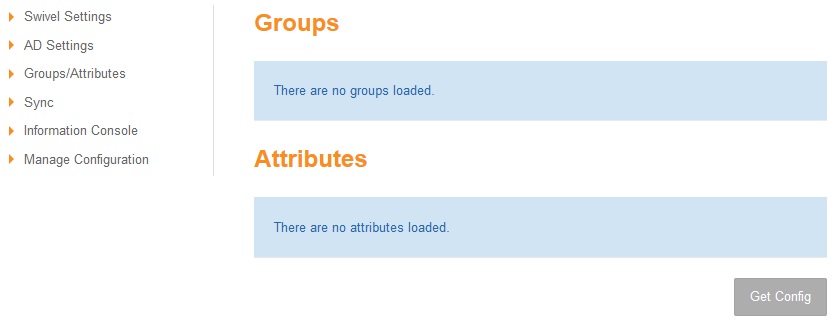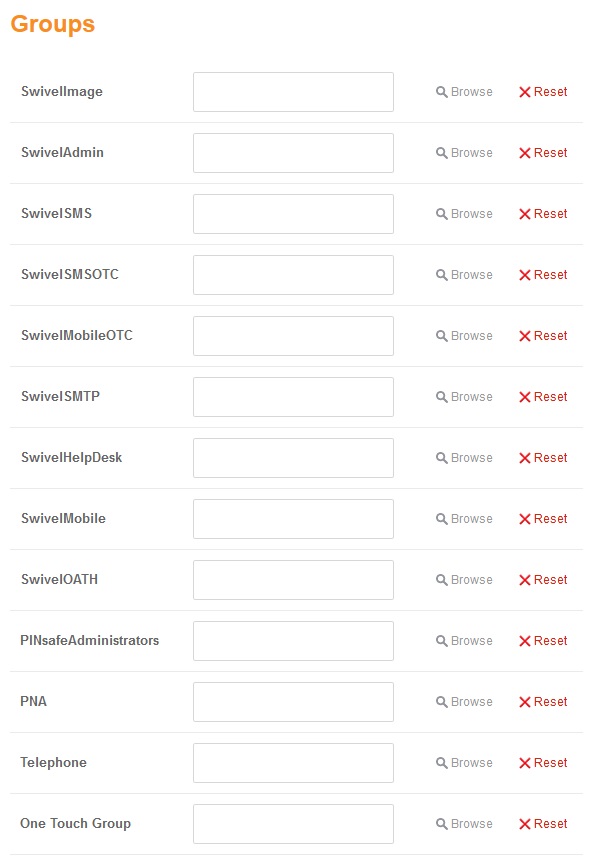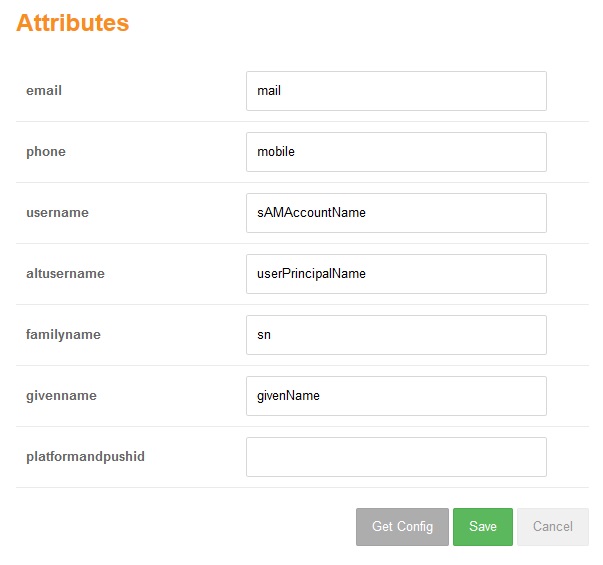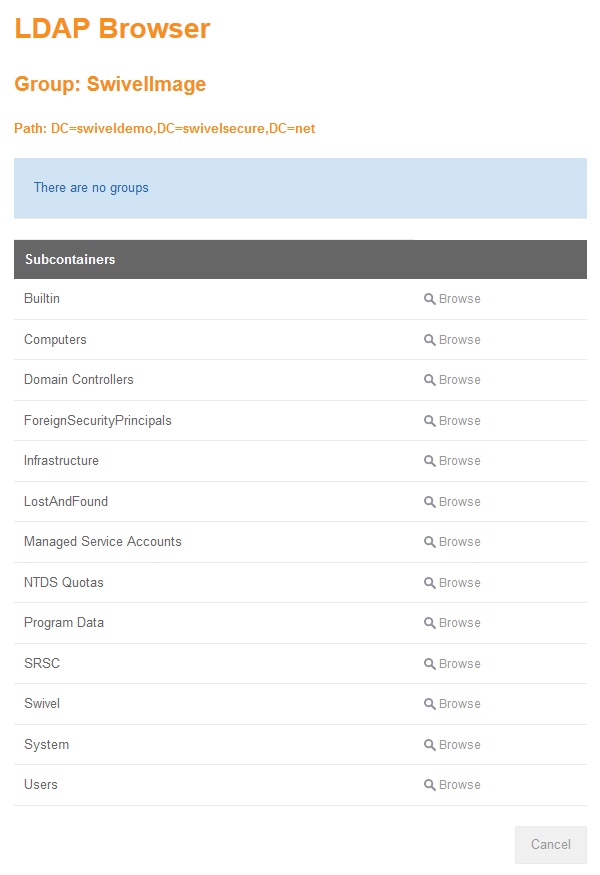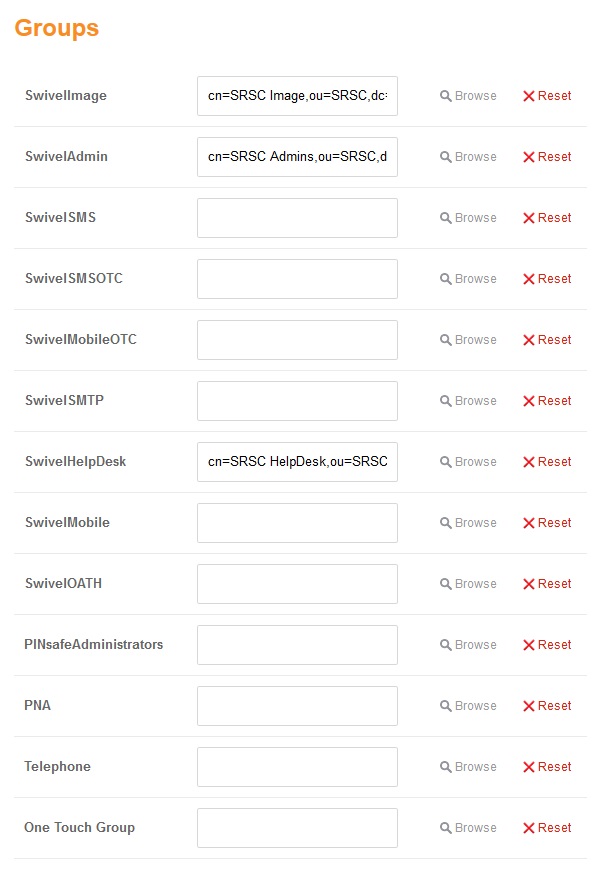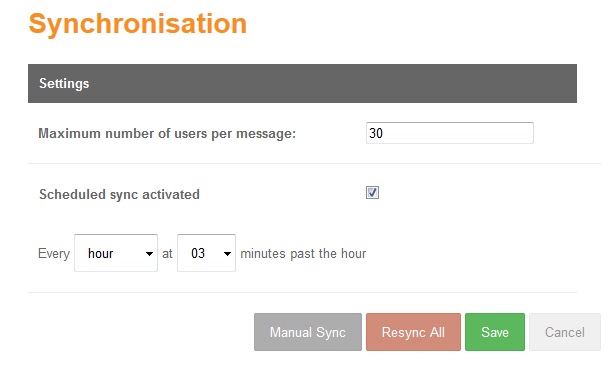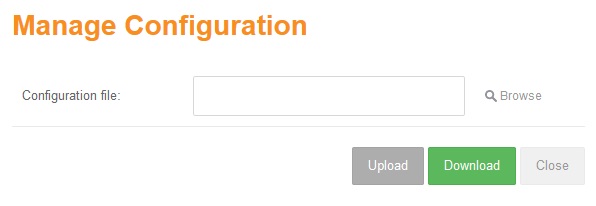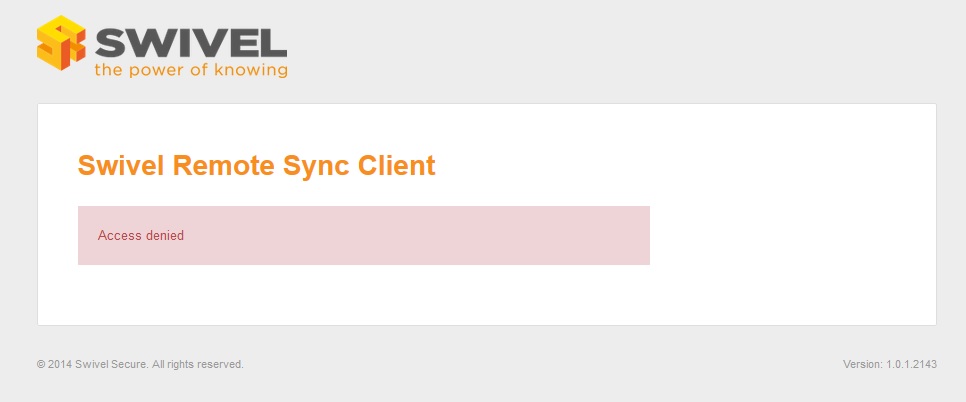Difference between revisions of "Swivel Remote Sync Client"
(No difference)
|
Revision as of 19:07, 4 July 2016
Contents
Overview
The Swivel Secure AD Agent (AD Agent) allows data from a data source (e.g. Active Directory) to be pushed to a Swivel Server. The AD Agent can be used with a Swivel Secure instance deployed within the Cloud. Users are added to the appropriate repository and appear in the User Administration on AuthControl Sentry. The AD Agent runs under Tomcat and requires JAVA. The Windows installer contains all the required software elements and configures the software to run.
Prerequisites
AD Agent Installer.exe file from the Downloads page
Windows OS with Java or Swivel appliance
Swivel Configuration
Configuring the Server Agent
On the AuthControl Sentry Administration console configure the Server Agent, see Agents How to Guide. The following settings need to be configured:
Name
Hostname/IP of the AD Agent
Shared Secret: same value entered on AD Agent server
Can Act as Repository: Yes
URL Check Repository: https://IP_of_the_SRSC_server:8080/adagent/adminxml
Encryption/Deccryption key: same value entered on AD Agent server
Enabling Session creation with username
To allow the TURing image, Pinpad and other single channel images, under Server/Single Channel set Allow session request by username to Yes.
AD Agent Installation
Windows Installation
Download the AD Agent installer to where the AD Agent is to be run from, and run the installer.
AD Agent Settings
Run the AD Agent configuration program, and enter in the Cloud details supplied by Swivel.
AD Agent Administration security
The AD Agent Administration console can be protected by IP source. Edit the file .swivel/srsc/security.properties. After editing, Tomcat will need to be restarted, or on Windows quit and restart the console.
To allow access from any IP use 0.0.0.0/0
To specify a range of IP's or a specific IP specify the IP and netmask
admin.iprange=192.168.11.0/24 core.iprange=192.168.11.115
AD Agent Login
In a web browser connect to http://local_server_ip:8080/adagent, a login screen should appear, allowing login from a Swivel Administrative user account.
A Successful login brings up the configuration options:
AD Agent Configuration - Swivel Settings
Encrypted Key: Indicates if the messages sent/received will be encrypted/decrypted. The value has to be the same as the encrypted key configured in the Agent. If empty the messages won’t be encrypted/decrypted.
URL check password: indicates the URL where the SRSC is listening for requests to check password
Note on Check Password
In the Swivel Settings screen there is a field to indicate the URL of SRSC that is listening requests. This parameter is sent in the “Get Config” message to the Core, and is saved as information of the Agent. NOTE: if this value is changed directly in the Core when a synchronisation is done or a get config message is sent, it will be changed again with the value sent by AD Agent. That URL is used by the Core to check the password of the users created through this Agent ONLY if the Agent XML or RADIUS has been configured as “Check password with repository”
AD Agent Configuration - AD Settings
Allows settings to configure ctive Directory data source
Server: IP/Hostname where the AD is running.
Port: Port where the AD is running.
Username: AD administrator username
Password: AD administrator password
SSL: Checked if the connection is SSL, unchecked otherwise.
Self-Signed Certs: If checked indicates that in a SSL connection self-signed certs are accepted.
Username attribute: Indicates the username’s name attribute. By default: sAMAccountName
Base DN: Indicate the BaseDN, if empty will be root.
Group ObjectClass Name: Indicates the group object class name attribute. By default: group
User ObjectClass Name: Indicates the group object class name attribute. By default: user
Member attribute name: Indicates the member’s name attribute. By default: memberOf
Last modification attribute name: Indicates the last modification’s name attribute. By default: whenchanged
NOTE: Currently AD Agent gets only no disabled users, and to do that a rule has been added: “!UserAccountControl:1.2.840.113556.1.4.803:2” this rule works for AD and it is something not configurable by the user in the application. This rule maybe is different for an OpenLDAP. So the good working is at the moment only covered for an AD.
AD Agent Configuration - Groups/Attributes
Get Config connects to the configured Swivel instance and loads the Groups and Attributes available.
The Browser screen shows the current AD Path, the name of the group that the user wants to assign a value on and a list of Groups and Subcontainers of the current path. When an AD group is selected it is automatically assigned to the group.
The second section on the Group/Attributes screen shows the attributes.
IMPORTANT: To save all the changes done in that screen “Save” button has to be clicked.
Browser Groups (imported from Swivel, values will depend n the Swivel setup)
Browser Attributes (imported from Swivel, values will depend n the Swivel setup)
Browsing to the groups
Selecting the Groups
Selected Groups
AD Agent Configuration - Sync
In the synchronisation screen, the user can indicate the maximum number of users that will be sent per message. If the number is 0 or less it will indicate that is not limit defined. Furthermore, the user can decide to do a Manual Sync clicking the corresponding button and/or define a scheduler for an automatic synchronisation. Also, there is a button to resync all the users.
The sync process involves the exchange of different types of messages as follows:
- AD Agent Request - Get Config / Response - Get Config (Groups and Attributes)
- AD Agent:
Groups not defined: Request - Error Groups / Response - Error Groups
All groups defined: No message
- AD Agent:
Get users members of the groups defined from AD
If there are users that have to be sync, the number of messages will depend of the maximum number of users per message
Request - Sync Users / Response - Sync Users
Update users last sync data if no error
No users to sync: no message sent
Information about the last synchronization (Manual or Scheduled) is shown. The information is as follows:
- Last sync date: date and time of last sync
- Type: Manual/Scheduled
- If there are groups not defined: Name of the groups not defined
- Created or updated users: number of OKs, number of FAILs
- Deleted users: number of OKs, number of FAILs
When a user has been synced with the Core, the next synchronization will not be update again unless:
- Data of that user has been updated in the AD after last sync, e.g. whenChange > lastSyncTime
NOTE: clocks of AD server and the SRSC has to be synchronized.
- There has been a change in the groups/attributes screen after last sync so next sync all the users will be updated.
Scheduled sync
To define a scheduled sync, set the field “Scheduled sync activated”, when this field is checked a new field/s appear under this field to defined the scheduler. When the scheduler is defined the user has to click “Save”, in than moment a job of synchronization will be started and executed every time that meet the time defined in the scheduler. If the job is already started and the user edit the scheduled time and press “Save”, automatically the job will be rescheduled but if the user set unchecked the activated field the job will be stopped.
Manual Sync
When the user clicks “Manual Sync” a confirmation dialog is shown, then if the user has accepted, a spinner overlap will be shown. That is useful to indicate to the user that the synchronization is working, mainly in synchronizations with a large amount of users that usually need more time and in addition, to avoid that the user clicks again Manual sync.
Resync All
This action allows to the user resync all the users independently of they were synced before or not.
NOTE: If the rights of the groups are changed in the Core those changes are not communicate to the AD Agent and the users won’t be updated. The next AD Agent synchronization won’t update the users of those groups if the data on the AD for that users has not be modified. In that case the resync all action has to be done to update the rights.
Manual Sync
AD Agent Configuration - Information Console
This shows the information about the messages exchanged between AuthControl Sentry and AD Agent. The messages can be deleted automatically using a schedule job that will be executed every day at 19:00. That configuration could be changed in the file distpatcher-servlet.xml if it was needed. The user can customize the deletion indicating the number of days that the info message has to have to be considered old and the next execution of the job it will be deleted. If the number the days is less than 0 all the messages will be deleted.
Example: Number of days 1 - the messages previous to the current day will be deleted.
AD Agent Configuration - Manage Configuration
The application allows download the current configuration or upload a configuration previously stored.
The configuration exported contains the following:
- Swivel Settings
- AD Settings
- Groups/Attributes
- Sync settings
- Information Console settings.
Testing
Known Issues
Troubleshooting
AD Agent:Message encrypted
Message seen on the Swivel Core Log Viewer for communication with the AD Agent.
Message decrypted
Message seen on the Swivel Core Log Viewer for communication with the AD Agent.
Searching encryption key for the IP: 192.168.12.110, agent name found: AD Agent
Message seen on the Swivel Core Log Viewer for communication with the AD Agent.
ERROR RestTemplateServiceImpl:72 - [MTD] sendPostMessage [MS
G] Error: org.springframework.web.client.ResourceAccessException: I/O error on POST reques
t for "https://192.168.12.111:8443/proxy/AdminXML": hostname in certificate didn't match: <192.168.12.111> != <*.swivelsecure.com>; nested exception is javax.net.ssl.SSLException: hostname in certificate didn't match: <192.168.12.111> != <*.swivelsecure.com>
Error seen in the AD Agent console for a certificate not matching the hostname. Select Self-Signed Certs.
ERROR ConfigurationController:81 - [MTD] getConfigRequest [MSG] Connection error
Error seen in the AD Agent console, unable to connect to the Swivel core.
Access Denied
If trying to access the login page goes straight to Access Denied, check the IP security filter addresses.
There was an error getting configuration In the AD Agent console
Response: Parse Error In the SRSC log
Check the AD data source configuration.
The 'Encrypted Key: needs to be configured with the Swivel core to match that under Sever/Agents for the correspoding AD Agent.
ERROR EncryptionUtility:103 - [MTD] initCiphers [MSG] Error: javax.crypto.BadPaddingException: Given final block not properly padded in the AD Agent program console.
The 'Encrypted Key: needs to be configured with the Swivel core to match that under Sever/Agents for the correspoding AD Agent.
AD Connection error in the AD Agent Administration console.
2015-04-07 12:57:18 ERROR ConfigurationController:148 - [MTD] ldapBrowser [MSG] Error: org.springframework.ldap.AuthenticationException: [LDAP: error code 49 - 80090308: LdapErr: DSID-0C0903A9, comment: AcceptSecurityContext error, data 52e, v1db1 ]; nested exception is javax.naming.AuthenticationException: [LDAP: error code 49 - 80090308: LdapErr: DSID-0C0903A9, comment: AcceptSecurityContext error, data 52e, v1db1 ] in the SRSC program console.
Use username@fqdn for the AD Settings

